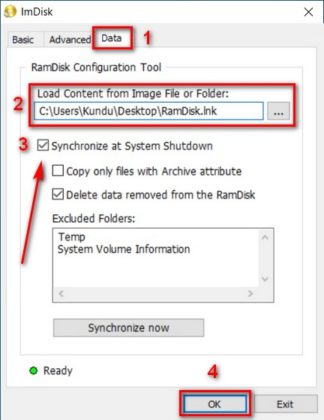

Multi-terabyte SSD storage has become common, but RAM is still measured in gigabytes. In many cases, the data stored on the RAM drive is created from data permanently stored elsewhere, for faster access, and is re-created on the RAM drive when the system reboots.Īpart from the risk of data loss, the major limitation of RAM drives is capacity, which is constrained by the amount of installed RAM. This is, in general, a weakness (the data must periodically be backed up to a persistent-storage medium to avoid loss), but is sometimes desirable: for example, when working with a decrypted copy of an encrypted file, or using the RAM drive to store the system's temporary files. few larger files (temporary internet folders, web caches, etc.).īecause the storage is in RAM, it is volatile memory, which means it will be lost in the event of power loss, whether intentional (computer reboot or shutdown) or accidental (power failure or system crash). Third, the file system in use, such as NTFS, HFS, UFS, ext2, etc., uses extra accesses, reads and writes to the drive, which although small, can add up quickly, especially in the event of many small files vs. Compounding this limitation is the speed of the actual mechanics of the drive motors, heads, or eyes. Other forms of storage media are further limited by the speed of the storage bus, such as IDE (PATA), SATA, USB or FireWire. Second, the maximum throughput of a RAM drive is limited by the speed of the RAM, the data bus, and the CPU of the computer. RAM drives can access data with only the address, eliminating this latency. magnetic bubble, acoustic storage, magnetic tape) must move the information to a particular position before reading or writing can occur. A physical hard drive, optical (e.g, CD-ROM, DVD, and Blu-ray) or other media (e.g. This performance gain is due to multiple factors, including access time, maximum throughput, and file system characteristics.įile access time is greatly reduced since a RAM drive is solid state (no moving parts).

The performance of a RAM drive is generally orders of magnitude faster than other forms of digital storage, such as SSD, tape, optical, hard disk, and floppy drives.

So RAM devices do offer an advantage to store frequently changing data, like temporary or cached information. Primary memory writes do not so or in far lesser effect. However, solid-state devices do suffer from wear from frequent writing. In the advent of solid-state devices this advantage lost most of its appeal. Historically primary storage based mass storage devices were conceived to bridge the performance gap between internal memory and secondary storage devices.
#Make ram disk software#
It is sometimes referred to as a virtual RAM drive or software RAM drive to distinguish it from a hardware RAM drive that uses separate hardware containing RAM, which is a type of battery-backed solid-state drive. They are in a sense the reverse of virtual memory: RAM drive uses a volatile fast memory as if it's a nonvolatile slow memory. RAM drives provide high-performance temporary storage for demanding tasks and protect non-volatile storage devices from wearing down, since RAM is not prone to wear from writing, unlike non-volatile flash memory. For filesystems without drive emulation, see tmpfs.Ī RAM drive (also called a RAM disk) is a block of random-access memory ( primary storage or volatile memory) that a computer's software is treating as if the memory were a disk drive ( secondary storage). For hardware storage devices using RAM, see solid-state drive. This article is about virtual drives emulated with software.


 0 kommentar(er)
0 kommentar(er)
